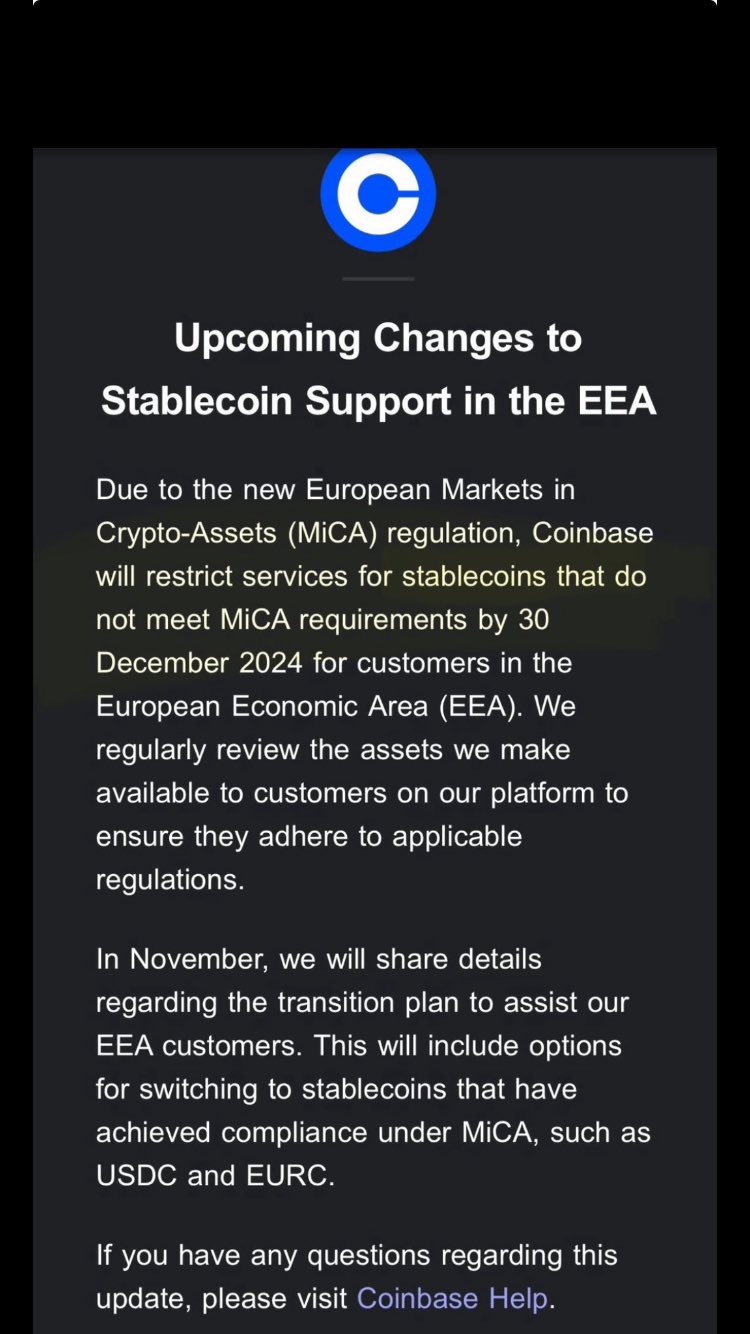So, I recently sat down to unpack something that’s causing quite a stir in the crypto space: Coinbase’s decision to delist USDT (Tether) in the EU, all to align with the new MICA regulations coming into effect in December 2024. When I first heard the news, my gut reaction was to wonder why USDT—being the largest stablecoin—was getting cut while USDC was staying put. There had to be more to the story, and as always, it’s in the details.
Let’s start by understanding the significance of stablecoins like USDT and USDC. Whether you’re deep into Bitcoin, Solana, or Ethereum, you simply can’t escape stablecoins. They’re the bridge between the volatile world of crypto and traditional finance. But now, Europe is shaking things up with MICA, a regulation that’s been years in the making. It aims to bring more structure and safety to the crypto world, giving it a clearer path forward.
The big question is: why Tether? Why is USDT being singled out? And why, despite being the second largest stablecoin, is USDC spared?
First, let’s talk about MICA. This new framework isn’t just a hurdle for innovation, as some might think. It’s actually an essential step forward. If you look back to 2017, I was part of a project that launched one of the first semi-stablecoins on Ethereum. We worked on stabilizing prices through algorithms, and trust me—regulation would have made things much easier for us back then.
MICA is trying to accomplish something similar by creating “asset reference tokens.” These tokens are essentially stablecoins backed by specific currencies or a basket of assets. They’re different from CBDCs (central bank digital currencies), but they serve a similar role in providing a trusted medium of exchange.
The core of MICA’s requirements boils down to transparency and accountability. Stablecoins need to be backed 1:1 with reserves. If you issue a digital dollar, you need to have a real one sitting in reserve somewhere. This is crucial for user protection, and I think it’s a solid requirement. So, when you think about Tether’s delisting, it comes down to this: they haven’t fully aligned with these strict requirements yet. Despite having years to prepare, it seems Tether is still playing catch-up.
But what about USDC? Circle, the company behind USDC, is well ahead of the curve. They’ve already published their white paper, as required by MICA, and are fully transparent about their reserves. If you dig into Circle’s white paper (which you can find online), you’ll see that they’ve aligned themselves with European KYC (Know Your Customer) and AML (Anti-Money Laundering) laws. They’ve even detailed what would happen in the unlikely event of insolvency, covering all their bases.
This brings us to another key issue: custody of the reserves. According to MICA, stablecoin issuers need to keep their reserves with regulated entities. These could be financial institutions, crypto custodians, or exchanges. Tether has taken some flak for holding a portion of their reserves in commercial paper and certificates of deposit, rather than just cash or treasury bills. While this isn’t necessarily a red flag, it’s likely one of the reasons they’re being pushed to adapt faster.
Now, you might remember Luna and Terra, two so-called “stablecoins” that imploded spectacularly, wiping out billions. They had reserves, sure, but their lack of transparency and a proper framework led to disaster. MICA aims to prevent exactly that kind of catastrophe by enforcing strict regulations on what constitutes a reserve and how it should be managed.
What’s next for Tether? Well, I believe they’ll adapt. They’ll write that white paper, shore up their reserves, and comply with MICA. Other players, like Revolut and TransferWise, are eyeing the stablecoin space as well, and I wouldn’t be surprised to see more European-focused stablecoins launching soon.
Contrary to popular belief, I think the future for stablecoins in the EU is bright. This new regulation isn’t a death knell—it’s a framework that gives everyone clear rules to play by. Once Tether and other stablecoins get on board, the entire ecosystem will be stronger for it.
So, what do you think? Is this the push Tether needs to finally step up their game, or do you see it as a sign that we’re heading into a future with more diversified stablecoins? I’m keen to hear your thoughts—let’s keep the conversation going.

13 responses to “Coinbase delisting USDT tether from the EU – Analysis”
buy enclomiphene purchase line
how to buy enclomiphene buy in the uk
acheter kamagra pharmacie vente cependant
generique kamagra sans prescrire france
cheapest buy androxal buy uk no prescription
purchase androxal purchase line
buying dutasteride generic online uk
how to order dutasteride cost on prescription
buy cheap flexeril cyclobenzaprine buy dublin
online order flexeril cyclobenzaprine buy for cheap
buy gabapentin price dubai
cheap gabapentin generic new zealand
is it legal to buy fildena online from canada
how to buy fildena usa seller
how to buy itraconazole cost insurance
how do i get itraconazole without a prescription
buying staxyn cheap online no prescription
order staxyn generic online cheapest
ordering avodart american express
avodart London over the counter
get rifaximin generic online uk
ordering rifaximin generic available in united states
cheapest buy xifaxan cheap prices
buy xifaxan canada shipping
koupit levné kamagra bez lékařského předpisu
vente kamagra